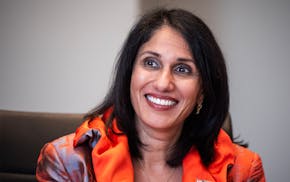Today let's catch up with developments and reader reactions from some columns over the summer, starting with news that Minnesota didn't have a recession this spring.
Twice in July, I mentioned recession was a possibility for Minnesota after the state's economic output fell in the first quarter. A recession is generally thought of as two consecutive quarters of decline.
The second quarter data came out Sept. 27 and showed Minnesota's economy grew 1.3%. Which is good until seeing that slow pace ranked Minnesota 48 out the 50 states in economic performance.
And the two states that grew even slower, North Dakota and Alaska, were affected by this year's sharp fall in energy prices. The overall U.S. economy grew 3% in from April to June.
For Minnesota, farming, mining and forestry were trouble spots for growth, while state and local governments saw the biggest jump. The giant increase in state spending for the 2024-25 biennium is now visible in the output data.
Something is changing about Minnesota. The state's economic diversity for many decades insulated it from the bigger swings of the national economy. The state entered downturns later and exited them faster, for instance. Now, Minnesota is a negative outlier on GDP performance, just as it's been on workforce size the last few years.
As regular readers will know, I first suspect the impact of demographic change, particularly baby boomer retirements. I also believe Minnesota's government sector, from school districts to counties to the state, is drawing more capital and people from the private sector. Governments didn't use the pandemic to become more efficient the way businesses did.
That combination of forces is something we should all watch. Next year, more Minnesotans will be 65 than ever, likely leading to the biggest retirement exodus yet. Meanwhile, state government won't have a large surplus, and budgeting will be more difficult for legislators. This newspaper keeps reporting schools and local entities want more money.
Another update: The three houses being built in Tower from kits created in Norway are nearly done. I visited in mid-August when construction had been underway for just a few days and carpenters from Norway were showing a group from northern Minnesota how to assemble them most efficiently.
Orlyn Kringstad, the former mayor of Tower who is co-leading the development, texted last week there have been "bumps and grinds along the way, but everything is moving forward." His team aims to get three more done before winter sets in.
I heard from a greater-than-usual number of readers about my column last weekend that wrapped up the five-part "Persisting Paradox" series, which looked at Minnesota's racial history and the key Minnesotans of color hold to the state's future economic growth. I hear from more of you each day about those ideas, and I'll summarize the feedback later this month.
Except for that series, I heard the most from readers this summer about a column in July in which I took what I thought was a pretty middle-of-the-road view about the tension between economic growth and environmental sustainability. I cited a new book by the British data scientist Hannah Ritchie who argues that trade-off doesn't have to exist in the future.
A lot of you don't buy it, judging by your feedback, and are very sure the environment is in great trouble. Dave Roy of Chanhassen wrote the fallacy of my argument is apparent to anyone who sees chemical runoff in the water where the Mississippi and Minnesota rivers meet in the heart of the Twin Cities.
"We have known about and done little to address the pollution from farm runoff, yet it continues and worsens as farmers tile their land. Yeah, there are a few responsible farmers out there, but not enough to make a difference. Ultimately, it is the almighty dollar that speaks the loudest and wins out over what is in the best interest of the environment," Roy wrote.
Tony Keenan of Columbia Heights gently said he wasn't sure I was right when I wrote that a clean environment is "lower on the hierarchy of human needs" than water, food and housing. "It seems to me that, if we do not have a livable planet and an economy based on sustainable principles, then nothing else matters because the human race will eventually perish," Keenan wrote.
And I really went too far for Edward Mutsch of Shorewood by saying that greater wealth allows communities to spend more on improving the environment. That could happen but it's unlikely, Mutsch wrote, "since the overwhelming percentage of that wealth increase had gone into the pockets of the wealthy and subsequently invested in ways to make the wealthy wealthier, rather than invested in ways to make American life better for everyone."
My interview last month with Carleton College economist Nathan Grawe about the financial challenges facing higher education led former Gov. Arne Carlson to write and observe colleges since World War II have grown without the constraint of market forces, becoming more bureaucratic and expensive along the way.
"Under this new paradigm, who were the winners?" Carlson wrote. "Certainly, it was not the student nor the faculty, particularly adjunct faculty. Putting aside coaches and the absurdity of their salaries, the real winners were the administrators. What an oddity that public higher education institutions that cannot balance their budgets can command the highest salaries in the entire national public service sector."
Dale Weeks of Minneapolis suggested leaders of the University of Minnesota and others study the finances of Purdue University, which hasn't raised tuition for 13 years. "In all candor, we in Minnesota are behind as a global leader in how we manage our higher ed institutions," Weeks wrote.

Ramstad: Minneapolis' Camden neighborhood is rising. Houston White wants to keep it that way.

Ramstad: Minnesota's big businesses are in crisis with a common problem

Ramstad: No business can 'eat' all the tariffs, not even Walmart

Ramstad: Donaldson is protected from tariff chaos after expanding globally the right way


